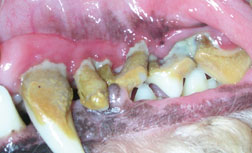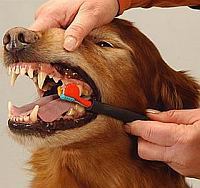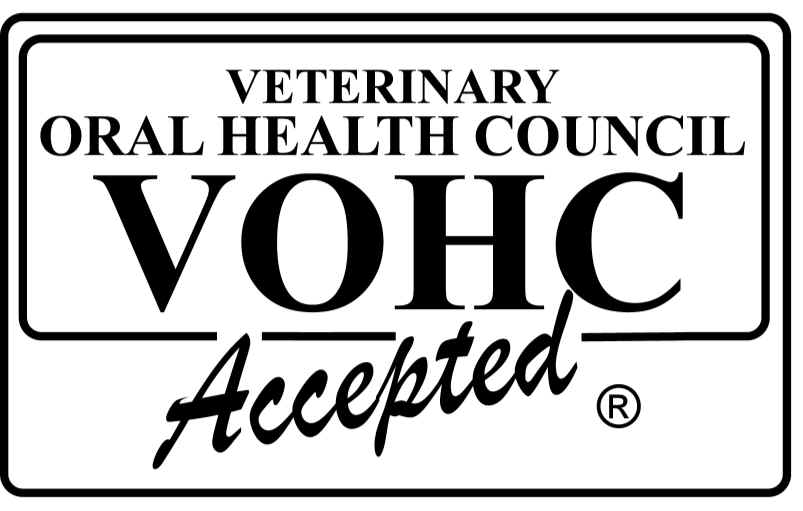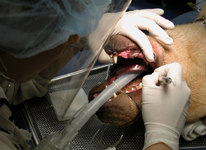A Healthy Mouth at Any Age
Pets are an important part of our lives. As such, dental care is important to extend your pet’s good health and quality years. Dental disease is the most common problem seen in our pet population today. More then 85% of all dogs and cats presented to veterinarians are affected by dental problems.
 Periodontal disease is caused by the accumulation of bacterial plaque on the teeth and surrounding gums, resulting in the inflammation of the surrounding tissues (gingivitis.) Left unchecked, gingivitis leads to loss of tissue attachment, and eventually, bone loss around the teeth. It is possible for oral infections to enter into the blood system and travel throughout the body bringing life-threatening infection to the heart, kidneys and liver. In addition, an animal with a sore, infected mouth is more reluctant to eat. Weight loss and malnutrition may result.
Periodontal disease is caused by the accumulation of bacterial plaque on the teeth and surrounding gums, resulting in the inflammation of the surrounding tissues (gingivitis.) Left unchecked, gingivitis leads to loss of tissue attachment, and eventually, bone loss around the teeth. It is possible for oral infections to enter into the blood system and travel throughout the body bringing life-threatening infection to the heart, kidneys and liver. In addition, an animal with a sore, infected mouth is more reluctant to eat. Weight loss and malnutrition may result.
The pet owner’s goal should be to minimize the accumulation of plaque and tartar. There are many factors that affect plaque buildup from genetic influences and oral anatomy to at-home dental care and diet. With regular, routine examinations and a quality at-home dental care program, maintaining the oral health of the family pet is not as hard as you may think.
Brushing the Teeth
 Before beginning an at-home dental care program, have one of our veterinarians check the health of your pet’s mouth. Many older animals may need a dental prophylaxis (teeth cleaning) to remove existing plaque and tartar. Your efforts will be more successful if you start with a clean mouth.
Before beginning an at-home dental care program, have one of our veterinarians check the health of your pet’s mouth. Many older animals may need a dental prophylaxis (teeth cleaning) to remove existing plaque and tartar. Your efforts will be more successful if you start with a clean mouth.- Brushing your pet’s teeth is easy and quick once you know how it’s done. There are several different styles of pet toothbrushes, but a child’s soft brush may be used. Gauze wrapped around your finger also works well. Use only toothpaste especially formulated for pets that has enzymes that destroy plaque causing bacteria. Human toothpaste can cause stomach irritation.
- Begin slowly, take your time and be patient.
- Choose a quiet, non-hectic time of the day. Sit down next to your pet and just pet and rub the muzzle without touching the mouth.
- Gradually increase handling to 2 or 3 minutes – the time it usually takes to brush the teeth.
- Offer toothpaste on your finger to see if your pet will lick it. Pet toothpastes come in several flavors, including seafood and poultry. Make sure to find one your pet likes. As your pet licks the paste, slowly try moving your finger into the animal’s mouth between the cheek and teeth. Caution: To avoid being bitten, do not place your fingers in between your pet’s teeth.
- If your pet does not like the toothpaste, try dipping the toothpaste in bouillon or tuna juice and offering it that way.
- Now, try using a pet toothbrush in place of your finger allowing the pet to lick the paste and chew on the bristles.
- With the brush in your pet’s mouth, slowly try moving the brush in a circular direction, covering the entire exposed tooth.
- Do not attempt to brush the surface of the tooth which faces the tongue unless your pet is extremely cooperative.
Warning: If at any time your pet shows aggressive behavior towards you, stop and start over from the beginning. If your pet refuses to allow you to handle the muzzle and mouth, you will have to use another form of dental care other than brushing.
Be Patient. Getting your pet used to you handling the muzzle and face, and manipulating the mouth may take some time.
Be persistent. Don’t try once or twice and then give up. A pet’s tolerance for having their teeth brushed is a learning process just like learning to sit and stay.
Give Rewards. Give your pet plenty of praise. Follow up every cleaning session with a special treat or playtime. Never punish or yell as they will only learn to fear having their teeth cleaned.
Diet
 The single easiest aspect of dental care to control is diet. Diet directly affects accumulation of plaque and tartar. Dry food, the larger the pi eces the better, is superior to semi-moist and canned foods which stick to the teeth encouraging plaque and tartar buildup. Look for the official seal of the Veterinary Oral Health Council (VOHC) on the packaging of those treats and diets that meet the standards of the VOHC.
The single easiest aspect of dental care to control is diet. Diet directly affects accumulation of plaque and tartar. Dry food, the larger the pi eces the better, is superior to semi-moist and canned foods which stick to the teeth encouraging plaque and tartar buildup. Look for the official seal of the Veterinary Oral Health Council (VOHC) on the packaging of those treats and diets that meet the standards of the VOHC.- For dogs, biscuits, rawhides, rubber or nylon toys also help maintain oral health. Although none are universally effective, studies show that rawhide chews are superior to the others. (In these studies, they fed 3 rawhide strips per week.) Biscuits do a good job in decreasing plaque build up, with large biscuits working better than small ones. The benefits of feeding hooves or large beef bones are outweighed by the number of fractured teeth and injured gums they cause.
- For cats, tartar control treats along with a dry food may help maintain oral health.
- There are foods specifically designed to control tartar and gingivitis. Hill’s Prescription T/D (Tartar Diet) is a 100% nutritionally complete diet which is highly palatable and excellent at helping to maintain a healthier mouth. If your pet has special health needs that are controlled by diet, you may want to feed the T/D as a daily treat after each meal.
- If your pet refuses to allow you to brush the teeth but appears to like the flavor of the toothpaste, trying smearing toothpaste on a hard, dry food such as a biscuit or T/D nugget. Give these as a treat after each meal. The scraping action of the hard food working in conjunction with the enzymes in the toothpaste is almost like brushing the teeth.
Dental Prophylaxis
Although diet, treats, and brushing can effectively retard dental disease, they cannot prevent it. Our veterinarians examine your pet’s teeth each year at the annual examination. Depending on the severity of dental disease, a dental prophylaxis (teeth cleaning) may be recommended.
 During a routine dental prophylaxis, your pet is placed under general anesthesia. Using forceps, built up tartar is removed. The teeth are then ultrasonically scaled to remove plaque and any remaining tartar. Because the scaling causes microscopic grooves on the surface of the teeth, they are then polished to smooth out these grooves and prevent plaque-producing bacteria from attaching to the clean tooth. The mouth is then rinsed with an antiseptic solution to decrease the bacteria population in the mouth. If any teeth are severely diseased, they are extracted by the doctor during the dental prophylaxis. Antibiotics may be dispensed depending on the degree of infection found in the mouth.
During a routine dental prophylaxis, your pet is placed under general anesthesia. Using forceps, built up tartar is removed. The teeth are then ultrasonically scaled to remove plaque and any remaining tartar. Because the scaling causes microscopic grooves on the surface of the teeth, they are then polished to smooth out these grooves and prevent plaque-producing bacteria from attaching to the clean tooth. The mouth is then rinsed with an antiseptic solution to decrease the bacteria population in the mouth. If any teeth are severely diseased, they are extracted by the doctor during the dental prophylaxis. Antibiotics may be dispensed depending on the degree of infection found in the mouth.
Let Us Help You
Our staff has many tips and techniques to help make dental care enjoyable and stress-free for you and your pet. So if you need further assistance, please give us a call. One of our technicians will be happy to help you.



